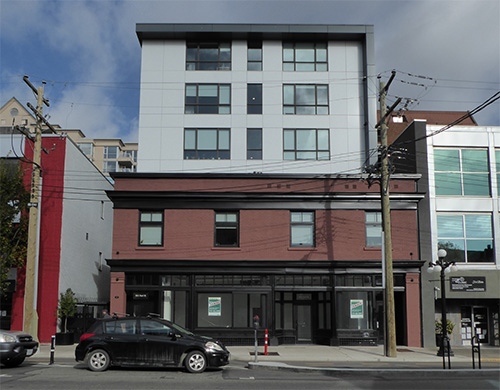ARCHITECTURE:
This modest two-storey, brick Edwardian commercial building has cast iron columns delineating the glazed, wood-framed storefront and three sheet-metal cornices defining the street front. There are four equally-spaced, multi-paned, second floor windows. The main-floor front façade has clerestory windows above four large glass panes and presently three entrance bays; originally there was just one entrance on the right. Despite the many alterations, the street façade notably retains many of the building’s original character-defining elements. A new six storey addition, set back from the front of the structure, contains a number of small, affordable-housing rental units. The project was assisted with a $13.25 M loan from CMHC’s federal Rental Construction Financing initiative. The project was done by Salient Group, president Robert Fung.
The Sawyer Building is valued for its mainstay as a commercial building and is an example of a modest, Edwardian, commercial style, typical of the era and location on upper Fort St. Walter Staneland strategically located his building along the arterial commercial and transit corridor of Fort St that would link traffic flowing from the downtown core to the outlying neighbourhoods of Rockland and Jubilee, taking advantage of the streetcar system that was constructed in the 1890’s to service the Royal Jubilee Hospital. The location of the building in the transition between the Core Business and Corridor Heritage areas adds to a blend of modest historic and modern buildings that provide a characteristic streetscape.*
ORIGINAL OCCUPANTS:
1909-46: Walter Ernest Staneland (b. Toronto 1875-1953) came here in 1899, married Lucy Maud (née Johnston, b. IRE 1877-1973) in 1900 and in 1905 started The Staneland Co, manufacturing and retailing paints. By 1909 he was prepared to take advantage of the pre-WWI real estate boom, with a prominent storefront close to downtown, providing paints, varnishes, and associated supplies. In 1911 Charles Elwood Watkins was commissioned to draft details to set back the front façade. It is believed that this work was commissioned to accommodate the widening of Fort St. The drawings noted that the present materials of the original façade were to be utilized in the new façade.
OTHER OCCUPANTS:
1946-65: Mowat-Grant Painting Ltd bought the business and building, and continued to operate as a retail store supplying paint and paint supplies.
1966-68: The business was known as Glidden Paint.
1969-2005: Sawyer Sewing Machines Ltd provided the building with its name. Further alterations were made to the storefront, relocating the main entrance to the R. In the 1970s, the building was subdivided into additional units offering space to a variety of retailers and professional firms.
* With info from City of Victoria’s Statements of Significance by John Dam & Assoc.


Recent Comments